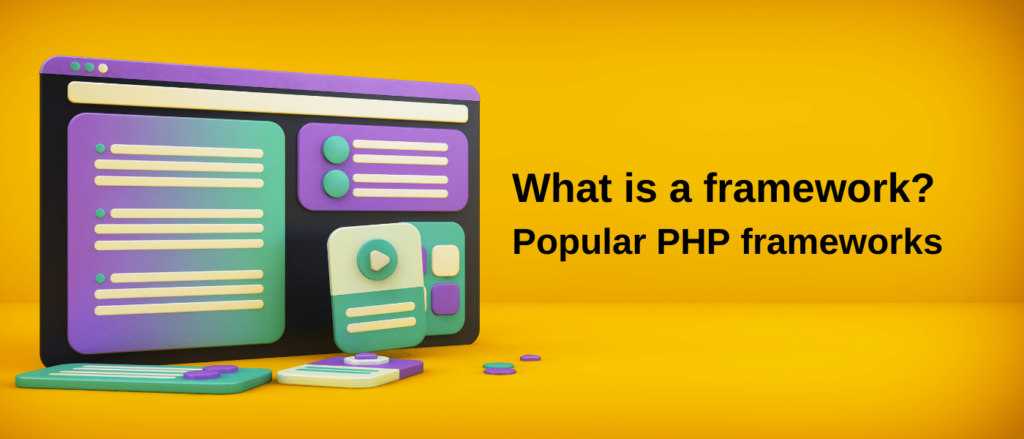In web programming, a “framework” is a collection of standardised code collections and tools for developing web applications and services. Frameworks speed up the development process and make it more efficient. Key advantages include reducing code duplication, helping to structure projects, standardising the development process and facilitating security and performance optimisations. The disadvantages can be a learning curve, lack of flexibility and sometimes performance concerns.
Let’s explain in detail the top 5 features of web frameworks and the benefits these features provide to programmers:
- MVC (Model-View-Controller) Structure:
- Content: MVC provides a separation between the application’s data model (Model), user interface (View) and business logic (Controller). This structure allows different parts of the application to be developed and managed independently.
- Benefits: The MVC structure facilitates code readability and maintenance. It also supports teamwork and modular development, allowing projects to be completed more quickly and efficiently.
- Ready-made Libraries and Tools:
- Content: Frameworks provide many features that developers often need; for example, database transactions, form validation, session management, and more.
- Benefits: These ready-made tools and libraries reduce repetitive tasks, speed up the development process, and reduce the risk of making mistakes.
- Security Features:
- Content: Web frameworks include security mechanisms that protect against common web attacks such as SQL injection, XSS (Cross-site Scripting), CSRF (Cross-site Request Forgery).
- Benefits: These features enable applications to be made more secure without requiring deep knowledge of security and significantly reduce potential security vulnerabilities.
- Efficient Data Management:
- Content: Many frameworks offer tools such as ORM (Object-Relational Mapping) that facilitate database operations.
- Benefits: ORM simplifies database queries and makes data access and manipulation more efficient and readable. It also provides migration tools for managing and implementing database changes.
- Community and Support:
- Content: Popular web frameworks usually have a large and active developer community. These communities provide support and guidance on various issues, plugins, and best practices.
- Benefits: This broad community support means an abundance of learning resources, quick resolution of issues, and a constantly evolving ecosystem. Developers can quickly and effectively improve their projects thanks to the plugins and modules provided by the community.
Top 5 Most Popular PHP frameworks
- Laravel: One of the most popular frameworks for PHP. It offers Eloquent ORM, Blade template engine, migration systems and comprehensive security features. Advantages include easy learning, strong community support, and high levels of security. On the downside, it can be overly complex for lightweight projects.
- Features: Eloquent ORM, Blade template engine, migration systems, extensive security features.
- Usage: Generally favoured by developers who like to write modern, clean and elegant code.
- Comparison: More user-friendly than Symfony, but not as flexible as Symfony. It offers more features than CodeIgniter and CakePHP and has a more modern structure. It is simpler and easier to learn compared to Zend.
- Symfony: A framework based on reusable components and standards. It also uses components of popular frameworks such as Laravel. Its advantages are modular structure, flexibility and broad community support. The disadvantage is the high learning curve.
- Features: Reusable PHP components, modular structure, performance and flexibility.
- Uses: Ideal for enterprise-level and customisable applications.
- Comparison: More complex and flexible compared to Laravel. More modular and extensible than CodeIgniter and CakePHP. Similar complexity to Zend, but differs with its component-based structure.
- CodeIgniter: A lightweight and performance-orientated framework. Ideal for small and medium-sized projects. Advantages include fast installation, easy learning and flexibility. The disadvantage is that it does not have as many features as other modern frameworks.
- Features: Lightweight, performance orientated, simple installation and flexible.
- Usage: Ideal for small to medium-sized projects.
- Comparison: Less features than Laravel and Symfony, but faster and lighter. It is simpler and easier to learn than Zend and CakePHP.
- Zend Framework (also known as Laminas Project): Used for enterprise-level web applications. It offers modularity and extensibility. Advantages are strong performance and flexible structure. Disadvantages are complexity and higher learning curve.
- Features: Modularity and extensibility, suitable for enterprise-level use.
- Uses: Preferred for large, complex and customised applications.
- Comparison: More complex and less user-friendly than Laravel and CodeIgniter. Similar level of complexity and flexibility to Symfony, but more enterprise orientated.
- CakePHP: Designed for fast and easy development. It simplifies CRUD (Create, Read, Update, Delete) operations. Advantages are fast prototyping and easy installation. The disadvantages are that it contains fewer features and lack of flexibility compared to other frameworks.
- Features: Fast prototyping, structure that facilitates CRUD operations.
- Usage: Ideal for projects that require rapid development.
- Comparison: Includes fewer features than Laravel and Symfony, but provides faster development. Similar to CodeIgniter, but offers more “out-of-the-box” features. It is simpler and less complex than Zend.
These frameworks are designed to meet various needs and expectations in the development of PHP-based web applications. It is important for developers to choose the most suitable one according to the requirements of their projects.

